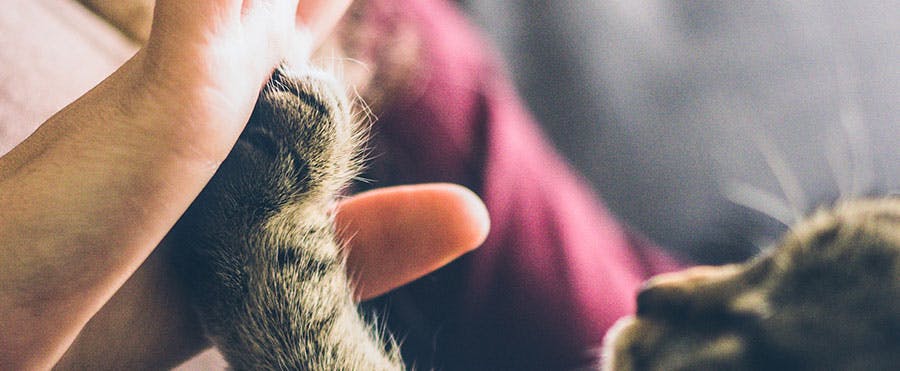Nothing beats that heart-melting moment when a cat cuddles up on your lap and gently massages you with its teeny paws, but what are they doing and why are they doing it?
The baffling behaviour is known as kneading and is performed by cats around the world. Also referred to as pawing, ‘making biscuits’ or ‘playing the piano’, cat kneading is a common query many kitty owners would like to clear up. So, we turned to our friends at the UK’s largest feline welfare charity, Cat’s Protection, and asked them to talk us through why cats knead.
Is my moggie trying to milk me?
Cat kneading is actually learnt as a kitten, but it sometimes stays with them through to adulthood. As a kitten, kneading serves a practical purpose as nursing kittens will knead around the teat of their mother in order to better stimulate the flow of milk.
Rest assured though, when your cat is pawing your lap, your belly, or your face, they aren’t trying to milk you. Although there isn’t a definitive answer as to why cats knead, there are a few compelling theories.
Trending posts
Purr-use some of the top blogs our members have been loving this month- Top male dog names for your new furry friendGot a new furry family member in your pack? Check…

- Top female dog names for your new fluffy palWelcoming a new pooch into your family? Explore…

- 250+ gray cat names your silver feline will loveRecently welcomed a fluffy gray bundle of joy into…

- What are normal pet sitting rates?Discover the average pet sitting rates for animals…

- Unique dog names to stand out from the packDare to be different with our list of the best…

Theory #1
The most widely shared theory is that when practicing this behaviour, cats are creating their own natural high through the release of chemical signals in the brain that contribute to the flow of happy and relaxing hormones.
As a kitten, they experience feelings of contentment when kneading their mother, and as an adult, they can replicate these feelings by pawing at our lap or on another soft surface. Kneading is normally accompanied by purring, so we can assume that your moggy is pawsitively content whilst pawing away.
Theory #2
Another widely supported theory is that rather than doing it by choice, cats knead because it is an engrained response. Sensations on the paw that cause kittens to knead during milking could be replicated by towels, bedding or your lap. As well as being stress relieving for your feline friend, it’s adorable for us to watch.
Theory #3
If we want to learn more about this curious cat behaviour, we can look to their wild siblings for a better understanding of why cats knead. Although they may not have a comfy blanket or a human lap to cosy up into, African wildcats will knead to flatten areas of long grass to sleep on or give birth. As both predator and prey in their natural habitat though, this is a lesser supported theory as African wildcats tend to sleep in raised areas to lookout for predators.
A more realistic explanation for this behaviour in both African wildcats and domesticated cats is that they are indulging in a bit of territorialism. With sweat glands in theirs paw pads, they are simply marking your lap or their bed as their property.
Should I stop my cat kneading?
Kneading is an instinctive behaviour, and also forms an important part of our relationship with domesticated cats, so should be encouraged. Unfortunately, some cats are known to paw with their claws, so be sure they have a sturdy scratch post to help them keep their claws trim.
Although the mystery of cat kneading is still being debated by pet parents and veterinary experts alike, one thing we do know for certain is that this adorable behaviour is completely natural and should be seen as a compliment. So, you should always be pleased if you’re pet sitting a cute cat and it starts kneading you; once a behaviour they did to get milk to survive, they’re now doing because they trust you and feel safe.
Does your cat 'knead' a kind and caring person to keep them company while you’re away? Explore the community of TrustedHousesitters and pore through plenty of cat-loving pet sitters who won't charge a penny to keep cute kitties like yours safe in their own home.
Purrs, meows, chirrups and chatters - it often feels like our feline friends have a lot to say. Next up, find out how cat talking buttons could be the key to communicating with your kitty cat.

